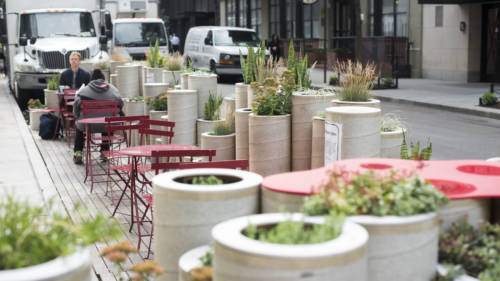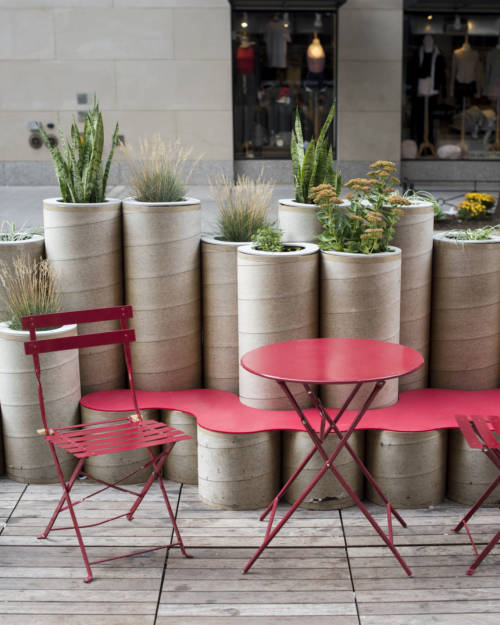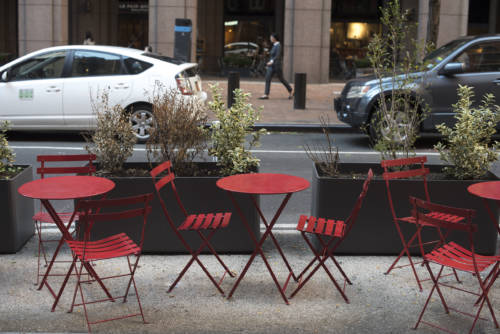
“Street Seats” Bring Temporary Gardens to New York
During the day, it might be difficult to get a seat in the New School’s “Street Seat,” a small elevated platform spanning part of the sidewalk and street, with benches, tables, and a garden.
Amidst the crowded city, this respite is part of a larger city-wide initiative led by the NYC Department of Transportation, “where local partners apply to transform underused streets into vibrant, social public spaces during the warm weather months” while creating green spaces throughout an urban environment.
The “Street Seats” operate as temporary functional installations between March and December. Currently, there are 14 locations installed throughout Manhattan and Brooklyn, spanning from TriBeCa, Downtown Brooklyn, Nevins Street, and the West Village, among other corners. The purpose is simple: to provide a greener space on the sidewalk curbs, for reading, eating, and sitting — a creative way to carve out new nooks in the city as well as to integrate a small dose of gardening into the city’s pavement.
The initial inspiration for the project came from examples of outdoor seating integrated throughout urban streets in Europe and the West Coast. The DOT began the initiative in 2010 and is currently in its 7th season.
To date, the DOT works with a variety of partners to create these “Street Seats”, from small businesses to organizations to Business Improvement Districts such as the Downtown Brooklyn Partnership, Lower East Side BID, and Pitkin Avenue BID. “It’s an application based program which means the public comes to us, and says, I would love to have a Street Seat in front of my establishment. It could be a business, a local community organization, and of course organizations, like universities,” Shari Glickman, the Project Manager told Garden Collage. (These islands usually span around 20 feet long, though the New School spans 40.)
At the New School location, cardboard cylinder tubes with a waterproof sealant serve as containers for plants, creating a natural screen between the bustling pedestrians. “One of our guidelines is that there should be greenery,” Glickman explains of the basic criteria for every application. The plants are usually integrated alongside the tables and benches in a similar fashion to the New School’s design. The partners of each project are then responsible for planting and watering the plants, making sure they stay clean and maintaining the overall space throughout the project’s duration.
In 2016, the DOT stated that they also reimburse new partners “for up to $12,000 and existing partners for up to $5,000 for the 2016 season for eligible purchases related to materials, fabrication and installation of the Street Seat.”
A wide range of design and creativity goes into establishing the 14 “Street Seat” locations throughout the city. “The New School is a special case in that every year they come up with a different design,” Glickman explains. These semi-temporary practical installations also allow for flexibility in material and structure. “The idea here is that it would be out here for the season and that next year the students will come up with a different design.”
The DOT also requires that the property owner the installation will be in front of also signs off on the project and that the Street Seats are approved by the local community board, at which point the design process begins. The collaboration between the DOT and their partners opens doors for new ideas and flexibility. “We allow everybody to pick what they want to do and that all typically depends on budget and how creative one wants to be. And then once the design is vetted through DOT, it’s fabricated by the partner and then it’s installed.” This process usually takes around six months; currently, the department is starting to work with partners for March, 2017.
Not every participating partner has to design their “Seat Street” from scratch, though. The DOT team has a customized design option, where the applicants make their own, and they also have a standard design, which they created with an architect last year to serve as a template for use in multiple locations.
Yet, the design component of these utile installations and the way they integrate greenery in surprising new ways is one of the exciting aspects of Street Seats, which would bode well if adapted in other cities. “We just installed one in Chelsea on West 20th Street, and they actually used boulders that they got from Upstate New York. The boulders themselves naturally have perched seating areas,” Glickman explains of the kinds of variations used throughout the projects.
As interest continues to mount, last year the DOT doubled the amount of “Street Seats” used in the program. Dispersed throughout Manhattan and Brooklyn, these little islands are a promising new way to imbue NYC’s pavement with welcome resting spots and an alluring touch of green.




































